Expert's Rating
Pros
- Very good Wi-Fi performance, whether purchased as a bundle with an Orbi router or added to an existing Orbi network
- Extends the range of your Orbi network while adding an Alexa-powered smart speaker to the mix
- Attractive industrial design and audio performance influenced by Harman Kardon
Cons
- Compatible only with Orbi-series routers
- Slightly inferior to the Sonos One in terms of musical fidelity
- Limited list of compatible music-streaming apps (and no Chromecast audio support)
Our Verdict
The Orbi Voice is a great addition to our favorite mesh Wi-Fi system, extending its range and bringing Alexa along for the ride. It’s not a great loudspeaker, but it is a very good one.
Netgear’s Orbi WiFi System (model RBK50) has been our top home router pick for more than two years, so we were intrigued when we learned that the company had partnered with the audio pros at Harman Kardon to build the Orbi Voice, an Alexa-powered smart speaker that operates as a satellite node in an Orbi-based mesh network.
The kit reviewed here, Netgear model number RBK50V, consists of an RBR50 router bundled with one Orbi Voice satellite (Netgear model number RBS40V) for around $380 on Amazon. If you already have an Orbi router, you can buy the Orbi Voice separately for an MSRP of $300 (Amazon was selling the satellite for $259 as I was writing this review). The smart speaker/satellite combo can be paired with any Orbi router, but the satellite will not work with mesh routers from other manufacturers.
And if you’re fortunate enough to have a large outdoor space around your home, Netgear has you covered with one of the only mesh nodes specifically designed for outdoor use: The Orbi Outdoor Satellite. The Orbi Outdoor can be mounted on a stand or hung on an exterior wall and is thoroughly weatherized (IP56) to protect it from the elements as well as errant sprinklers.
Orbi’s evolution
The Orbi ecosystem has evolved considerably since its introduction. In fact, it wasn’t even a true mesh Wi-Fi system when it first launched. Rather, it was a hub-and-spoke system in which Orbi satellites communicated directly with the router, versus the nodes communicating with each other. These days, Orbi systems can operate in daisy-chain mode, in which the network determines the fastest path that data can move over the network, whether that be directly from the satellite to the router, or from satellite A to satellite B (and so on) and then to the router.
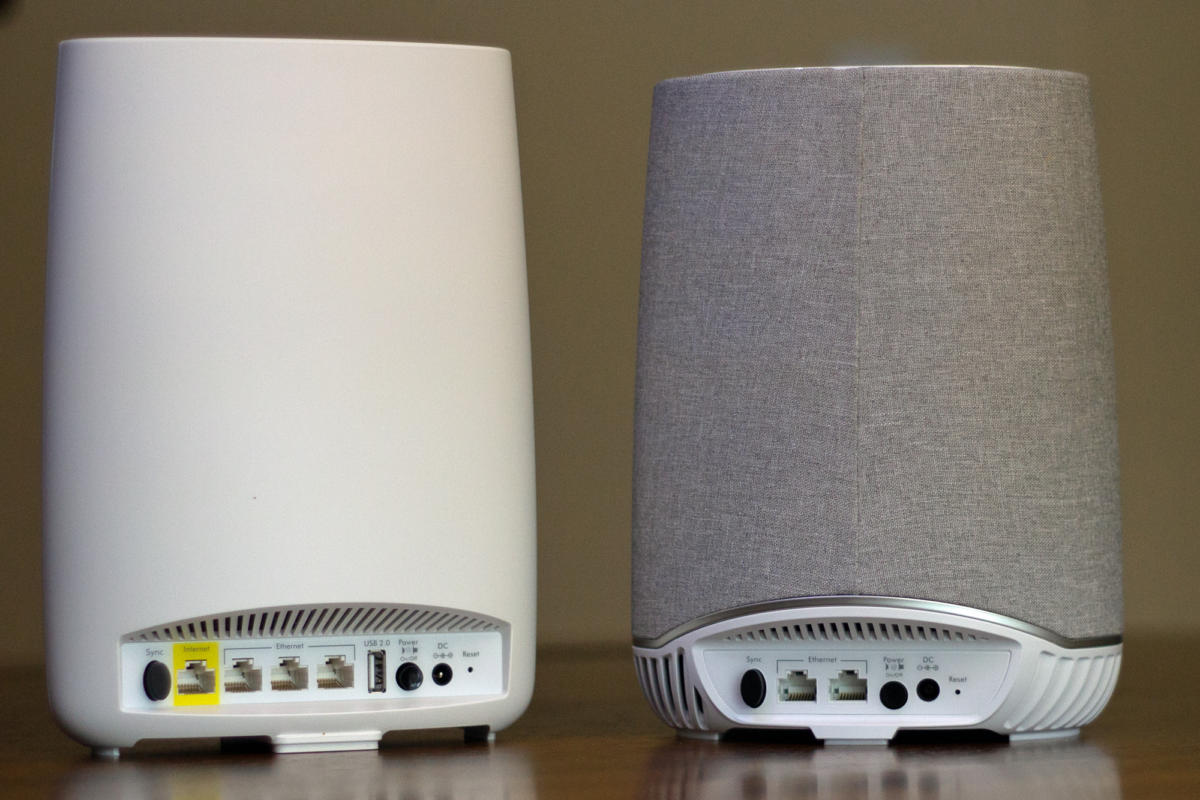 Michael Brown / IDG
Michael Brown / IDG
There was a time when Orbi mesh Wi-Fi systems didn’t support data backhaul over wired connections. They do now.
The other big change that Netgear implemented some time ago is to support hardwired backhaul to the router. Many newly constructed homes have ethernet inside their walls alongside electrical, telephone, and coax cables. And many hardcore tech enthusiasts have retrofitted older homes with ethernet. Installing low-voltage wiring such as this is a very DIY-friendly home-improvement project if you don’t mind scrambling around your attic, basement, or crawlspace and poking holes in your drywall. It doesn’t matter how fast your wireless network is, a wired network will always be faster.
Having wired nodes in a mesh network gives you the best of both worlds: Wired connections for speed, combined with wireless connections for convenience, so it was a bit of a head-scratcher when Orbi didn’t allow its satellites to use wired connections for backhaul. It does now.
Orbi Voice specifications
The Orbi Voice satellite is a tri-band device that can connect to three discrete networks: One on the 2.4GHz frequency band, a second using one swath of channels available in the 5GHz spectrum, and a third using a different swath of channels in that spectrum. I’ll dive deeper into that in the performance section, below.
 Michael Brown / IDG
Michael Brown / IDG
The Orbi Voice is much larger than the router that it’s paired with.
Orbi networks support all the leading-edge features you’d expect to find in an 802.11ac Wave 2 device, including band steering (the router automatically directs each wireless client to the most appropriate frequency band); MU-MIMO (multi-user multiple input, multiple output), which allows a router to transmit data to and receive data from multiple clients simultaneously; and beamforming, a technique that focuses the transmissions between the router and its wireless nodes on a mesh network.
The Orbi Voice has a two-port gigabit switch onboard, so it can operate as a wireless bridge for client devices that have ethernet adapters but not wireless capabilities (in which case you’d hardwire the device to the Orbi Voice and it would establish a wireless connection to your network). You can also hardwire the Orbi Voice to your network directly, to achieve data-backhaul speeds much faster than what’s possible with a wireless connection (as discussed earlier).
Netgear uses Circle for parental controls, which enables parents to control the time kids can spend on the internet, as well as where they go and which apps they can use. There’s a free tier with limited functionality, and a subscription unlocks additional features. Netgear Armor, powered by Bitdefender, is an optional service that promises to secure all your devices that connect to the Orbi network, including your smart home devices and your mobile devices (including when the latter are away from the network). There’s a free trial, after which the service costs $69.95 per year. I did not evaluate either of these features.
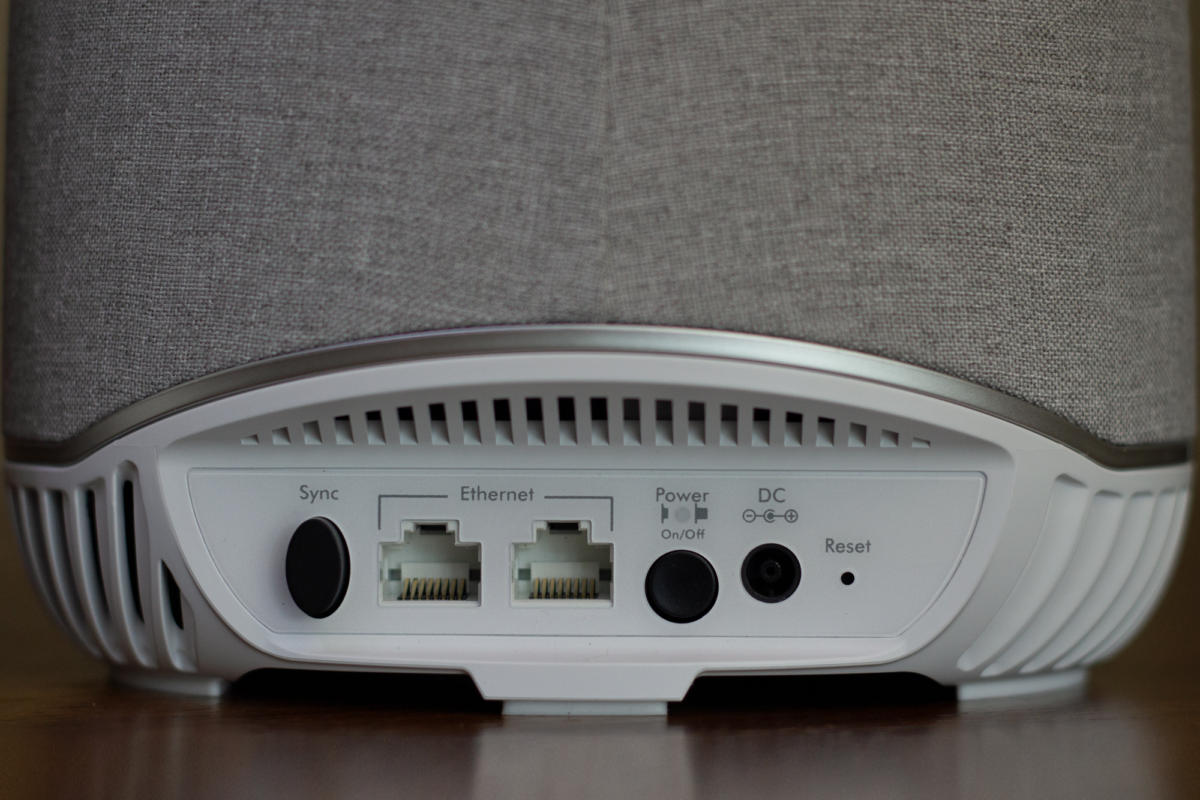 Michael Brown / IDG
Michael Brown / IDG
The Orbi Voice smart speaker has a two-port gigabit switch.
As a smart speaker, the Orbi Voice is outfitted with a 1.0-inch front-facing tweeter and a single 3.5-inch front-facing woofer, driven by an amplifier that delivers 35 watts of peak power (Netgear doesn’t publish RMS power ratings for the amp). The company claims frequency response of 63Hz to 20kHz. Four far-field microphones on top of the speaker await the Alexa wake word. I’ll discuss all this in more detail in the audio performance section, below.
A pair of backlit touch-sensitive buttons on top of the satellite mute the mic and the speaker, respectively. To adjust the speaker’s volume, you slide your finger over an approximately 4.5-inch curved strip. This is also backlit, and it changes brightness as you raise and lower the volume. A third touch-sensitive button gets Alexa’s attention without your needing to say the wake word. An oval ring of blue LEDs glows when Alexa is listening; the ring turns red when its mics are muted.
Speaking of mics, the Orbi Voice has four far-field mics mounted on top of the speaker, and they are very sensitive. They’ll hear the Alexa wake word even when music is playing loudly; in fact, they are so sensitive that it became something of a problem in my home. I have a lot of Echo devices in my home because I control so much of my Vivint Smart Home system with them. I have 35 Z-Wave nodes (mostly for smart lighting, but also for smart locks, a thermostat, and other IoT devices). I have Echo Shows in the kitchen, home theater, and master bedroom; an Echo Plus in my great room; a second-generation Echo Dot in the laundry room; and first-gen Echo Dots in my dining room, in the garage, and on my enclosed patio.
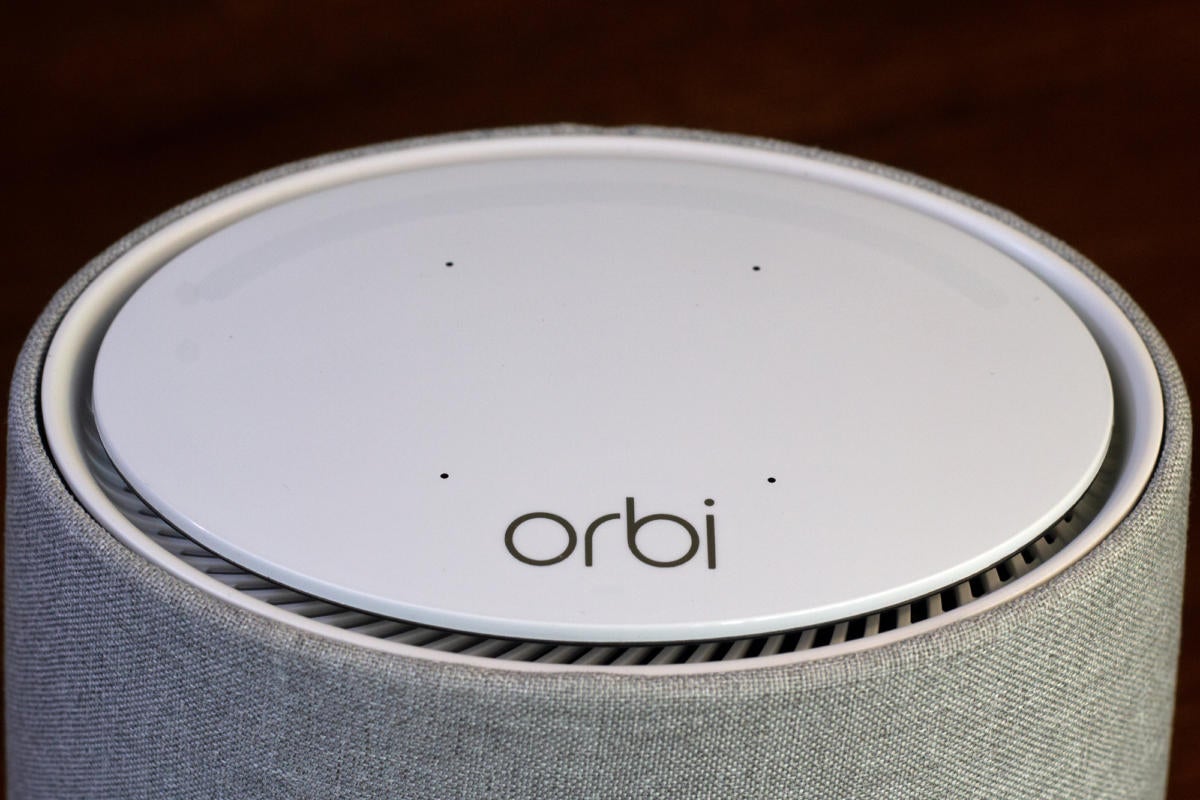 Michael Brown / IDG
Michael Brown / IDG
The Orbi Voice is outfitted with four very sensitive far-field microphones on its top.
The problem I experienced with the Orbi Voice is that its mics are so sensitive that saying the Alexa wake word in almost any interior room in the house triggered the Orbi Voice instead of the Echo speaker I was physically closer to. By the end of my review period, I had muted the Orbi Voice’s mics because it was driving me nuts demanding to be the center of attention.
Orbi Voice Wi-Fi performance
One of the reasons the Orbi RBK50 kit (an RBR50 router and one RBS50 satellite) I reviewed in 2017 delivers such high throughput is that both the router and its satellite are outfitted with six antennas, and they operate a third independent network using radios that support four spatial streams in each direction (4×4) for data backhaul at speeds as high as 1,733Mbps (433*4).
The Orbi Voice kit reviewed here includes that very same router, and Netgear’s RBS40V smart speaker is a tri-band satellite, but that satellite can’t take full advantage of the router’s capabilities. The reason why is that the satellite has only four antennas and supports only two spatial streams in each direction (2×2) on both of its 5GHz networks, so it can deliver data backhaul at a maximum rate of only 866Mbps (433*2).
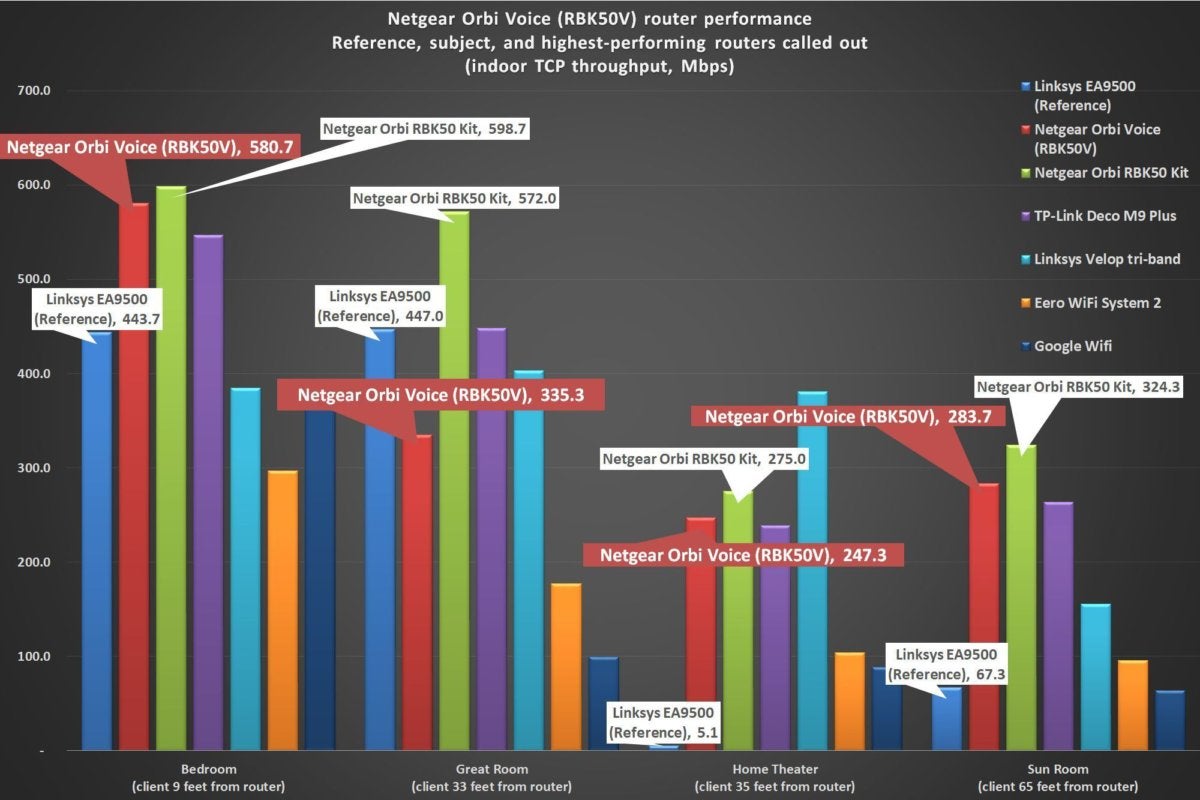 Michael Brown / IDG
Michael Brown / IDG
The Orbi Voice (RBS40V) when paired with an Orbi RBR50 router delivered very high throughput in every room in my home.
That said, the combination of the RBR50 router and the RBS40V Orbi Voice still create a very fast network. In a field that includes the Orbi RBK50 Kit, the Linksys Velop, TP-Link’s Deco M9 Plus, the Eero WiFi System 2, and Google Wifi, only the top-shelf Orbi and the three-node Velop delivered higher benchmarks in my 2,800-square foot, one-level ranch-style home. The Orbi RBK50 was fastest overall, but the Orbi Voice was faster than the Linksys Velop in three of the four locations that I placed my client laptop.
Orbi Voice audio performance
Netgear was smart to collaborate with Harman Kardon in designing the Orbi Voice’s audio elements. The brand is well respected among audio enthusiasts, so that nameplate imbues the satellite with well-deserved cachet. That said, I can name several other smart speakers that are more capable. For example:
- Amazon and Sonos let you augment their smart speakers with an optional wireless subwoofer. (The Polk Command Bar comes with a wireless sub in the box.) You can’t pair any sub with the Orbi Voice.
- Amazon, Sonos, Fabriq, and others let you pair two of their respective smart speakers as a left/right stereo pair. You can’t do that with the Orbi Voice.
- Amazon and Sonos allow you to build out a multi-room audio system that plays music in multiple rooms in sync. Amazon also allows you to combine its Echo smart speakers with third-party Alexa compatible speakers, but the Orbi Voice is not on that list.
The Orbi Voice, on the other hand, is the only smart speaker I’m aware of that can also extend the reach of your Wi-Fi network.
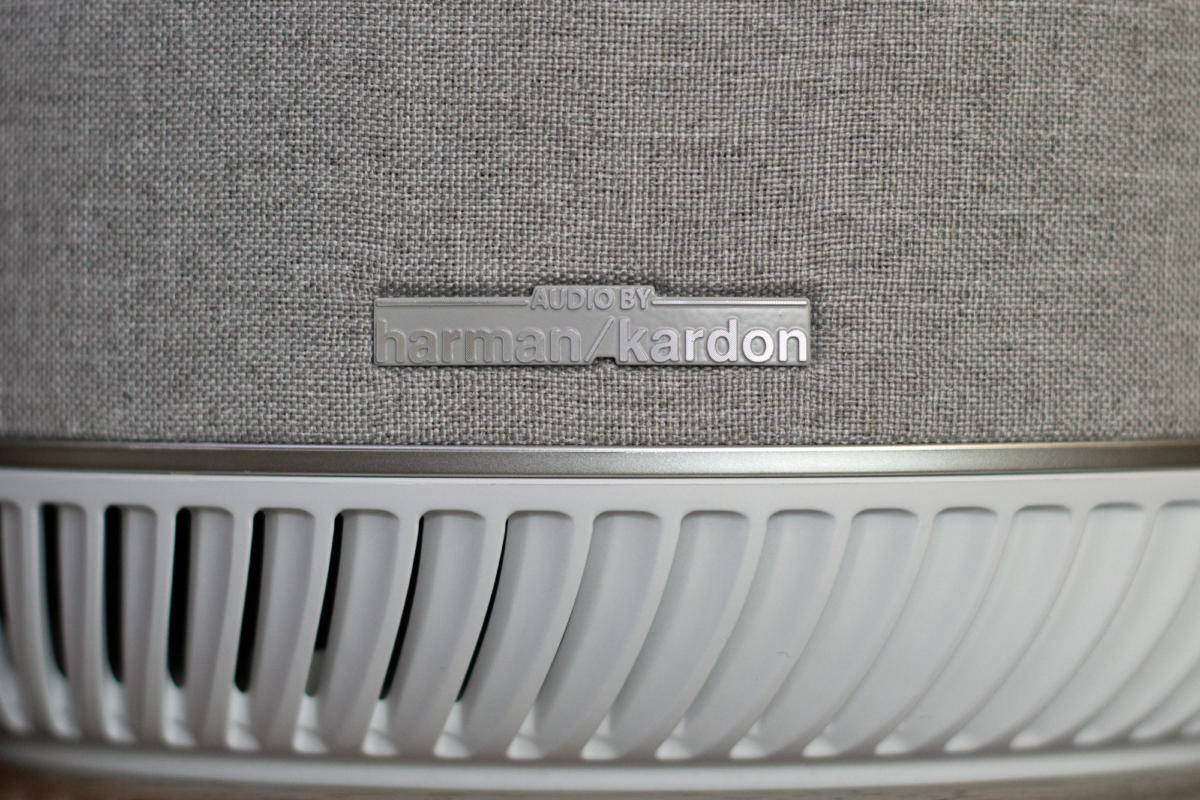 Michael Brown / IDG
Michael Brown / IDG
Harman Kardon helped craft the Orbi Voice’s audio components, but Netgear handled all the manufacturing.
The Sonos One is easily one of the best-sounding small smart speakers on the market, so I selected it for my A/B listening tests. Most people will use Alexa to initiate music streaming, but the Orbi Voice is also compatible with Spotify Connect, which you might prefer if you like to view album art while you’re listening, or if you just like Spotify’s well-curated playlists. Not a Spotify subscriber? You can also use Amazon Music, Pandora, or iHeartRadio. Netgear doesn’t provide an app that would make it easy to stream music stored on a NAS box, however, nor can you set up the Orbi Voice as a Chromecast speaker, which would allow you to use more streaming services, such as Qobuz, with it.
Like the Orbi Voice, the Sonos One is also a two-way speaker, with a tweeter and what Sonos calls a “mid-woofer,” but each driver is powered by a discrete Class D amplifier. This helps to explain why the Sonos One sounds so much better (it’s also louder).
I used a sound pressure level meter on my Pixel 2 XL to equalize the two speakers to the maximum output the Orbi Voice was capable of producing, so that I wouldn’t mistake loudness for quality. That was about 65dB as measured 24 inches from the speaker. (The Sonos One, for the record, peaked at just over 69dB). The Orbi Voice is a very good speaker for its size, but it’s nowhere near as faithful to the source material as the Sonos One is (and I don’t consider the Sonos One to be an audiophile-level speaker, either).
Listening to “Green Flower Street,” from Donald Fagen’s The Nightfly, the Orbi Voice was unable to clearly reproduce very high frequencies, such as the sizzle of the drummer riding his high hat. The instrument just got lost in the mix. This affected other sounds, too. Strikes of the snare drum, for instance, sounded like dull thuds because the sonic crack of the stick hitting the drum head was missing.
The Orbi Voice delivers good, but not great, bass response. The thumping bass lines and honking bari sax in Tower of Power’s “Squib Cakes,” from the band’s album Back to Oakland, lacked the urgency that finer speakers are able to deliver. The speaker also smeared Chester Thompson’s frenetic work on the Hammond B3 organ, so that it was hard to make out individual notes. That task can be difficult for any speaker to handle, but the Sonos One was better at it.
Bottom line
And that last observation sums up my opinion of the Orbi Voice quite well. In the end, it’s a better home networking device than it is a speaker—smart or not. I wouldn’t recommend it for critical listening sessions, but I wouldn’t recommend the Sonos One for that purpose, either.
If you need a router that offers very good range and high performance, or if you already have an Orbi router and you need to extend its range, the Orbi Voice can do that and deliver a pretty good musical performance wherever you place it and bring Alexa along for the ride. If you’re satisfied with your non-Orbi router, and you just want music and Alexa access in a location where you don’t have either now, the Sonos One is the better value. And it will soon support Google Assistant, too.


